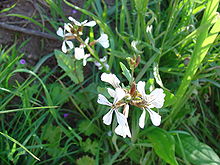
Bellis is a genus of flowering plants in the family Asteraceae.

Linaria is a genus of almost 200 species of flowering plants, one of several related groups commonly called toadflax. They are annuals and herbaceous perennials, and the largest genus in the Antirrhineae tribe of the plantain family Plantaginaceae.

Jovibarba is a small genus of three species of succulent flowering plants in the family Crassulaceae, endemic to mountainous regions in the southeastern quadrant of Europe. The genus is sometimes classified as a subgenus of Sempervivum, to which it is closely related. Jovibarba have pale-greenish-yellow or yellow actinomorphic flowers with about six petals, while Sempervivum have generally pinkish flowers with around twice as many petals, which open more widely than jovibarba flowers. The common name hen and chicks is applied to some Jovibarba species.

Dasiphora fruticosa is a species of hardy deciduous flowering shrub in the family Rosaceae, native to the cool temperate and subarctic regions of the northern hemisphere, often growing at high altitudes in mountains. Dasiphora fruticosa is still widely referenced in the horticultural literature under its synonym Potentilla fruticosa. Common names include shrubby cinquefoil, golden hardhack, bush cinquefoil, shrubby five-finger, widdy, and kuril tea.
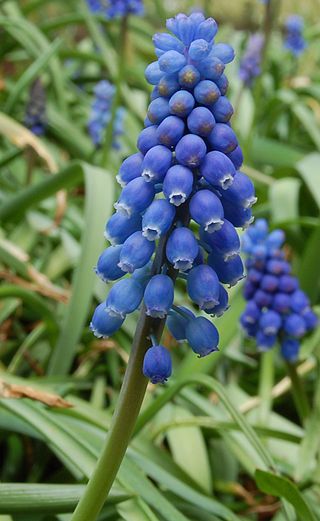
Muscari is a genus of perennial bulbous plants native to Eurasia that produce spikes of dense, most commonly blue, urn-shaped flowers resembling bunches of grapes in the spring. The common name for the genus is grape hyacinth, but they should not be confused with hyacinths. A number of species of Muscari are used as ornamental garden plants.

The genus Carthamus, the distaff thistles, includes plants in the family Asteraceae. The group is native to Europe, North Africa, and parts of Asia. The flower has been used since ancient times in the Philippines, which it has been called kasubha by the Tagalog people.

Anacamptis morio, the green-winged orchid or green-veined orchid, is a flowering plant of the orchid family, Orchidaceae. It usually has purple flowers, and is found in Europe and the Middle East.

Raphanus raphanistrum, also known as wild radish, white charlock or jointed charlock, is a flowering plant in the family Brassicaceae. One of its subspecies, Raphanus raphanistrum subsp. sativus, includes a diverse variety of cultivated radishes. The species is native to western Asia, Europe and parts of Northern Africa. It has been introduced into most parts of the world and is regarded as a habitat threatening invasive species in many areas, for example, Australia. It spreads rapidly and is often found growing on roadsides or in other places where the ground has been disturbed.
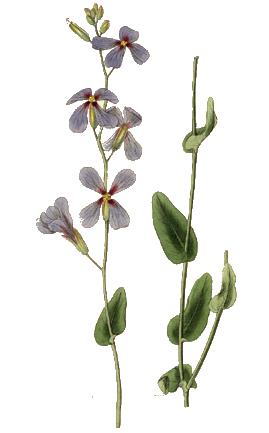
Moricandia is a genus of plants of the family Brassicaceae. This genus is mainly distributed in North Africa, the Middle East, and Southern Europe. It is associated with arid and semi-arid environments. Flowers of this genus are actinomorphic-dissymmetrical and mostly lilac in color, although they vary from white to purple depending on the species and climatic conditions. Some species show extreme phenotypic plasticity for flower size, shape, and color. The fruits are two-valved dehiscent siliques with one or two sets of seeds per valve.
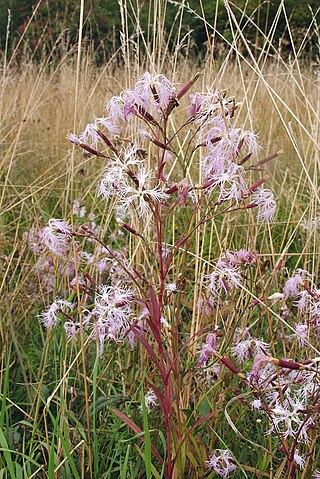
Dianthus superbus, the fringed pink or large pink, is a species of Dianthus native to Europe and northern Asia, from northernmost Spain and France north to arctic Norway, and east to Japan; in the south of its range, it occurs at high altitudes, up to 2,400 m.

Sisymbrium irio, London rocket, is a flowering plant in the cabbage family which is native to the Middle East, north Africa and southern Europe, and which has spread widely around the world as an invasive plant of dry, disturbed land in towns, deserts and farmland. It has traditionally been used as a medicinal herb for a variety of ailments. Its English common name originated when it flourished after the Great Fire of London in 1666, although it is not native to Britain and it does not tend to persist there.

Rhamphospermum arvense, the charlock mustard, field mustard, wild mustard, or just charlock, is an annual or winter annual plant in the family Brassicaceae. It is found in the fields of North Africa, Asia, Europe, and some other areas where it has been transported and naturalized. Pieris rapae, the small white butterfly, and Pieris napi, the green veined white butterfly, are significant consumers of charlock during their larval stages.

Draba verna, common whitlowgrass, is a species of plant in the cabbage family. It is a small spring-flowering annual which is widely dispersed around the world, and which is found on walls, pavements and patches of bare ground. It has a complex taxonomy which is not yet fully elucidated.
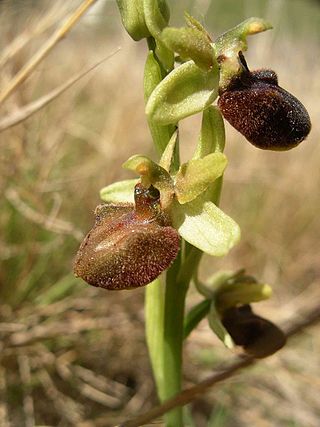
Ophrys sphegodes, commonly known as the early spider-orchid, is a species of sexually-deceptive orchid native to Europe and the Middle East. It is a very varied species with many subspecies recognised.

Rocket, eruca, or arugula is an edible annual plant in the family Brassicaceae used as a leaf vegetable for its fresh, tart, bitter, and peppery flavor. Its other common names include "garden rocket", as well as "colewort", "roquette", "ruchetta", "rucola", "rucoli", and "rugula". E. vesicaria is widely popular as a salad vegetable and it is a species of Eruca native to the Mediterranean region.

Diplotaxis tenuifolia is a species of flowering plant in the mustard family known by the common name perennial wall-rocket. It is native to Europe and western Asia, where it grows on disturbed ground and roadsides, and it can now be found throughout much of the temperate world where it has naturalized. In recent years it has increasingly been cultivated to produce salad leaves, which are marketed as wild rocket in Britain or arugula in the US. It is easily confused with garden rocket, which has similar uses.
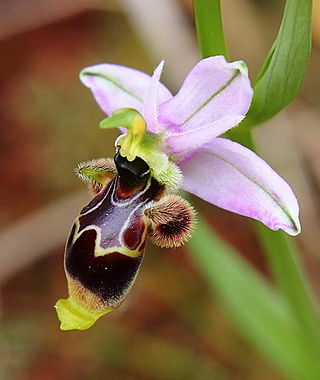
Ophrys scolopax, known as the woodcock bee-orchid or woodcock orchid, is a species of terrestrial orchid found around the Mediterranean and the Middle East, from Morocco and Portugal to Hungary and Iran.
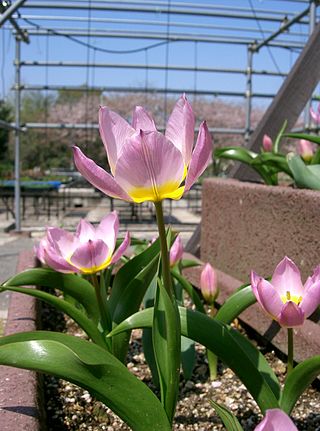
Tulipa saxatilis is a Greek and Turkish species of plant in the genus Tulipa of the family Liliaceae.

Crepis vesicaria is a European species of flowering plant in the family Asteraceae with the common name beaked hawk's-beard. It is native to the Western and Southern Europe from Ireland and Portugal east as far as Germany, Austria, and Greece. It became naturalized in scattered locations in North America.

Lepidium heterophyllum,, is a species of flowering plant in the mustard family which is native to parts of western Europe, growing in shingle banks, wasteland or cultivated fields.
